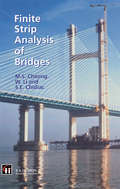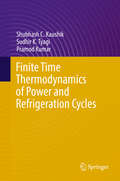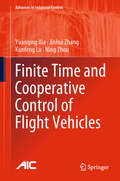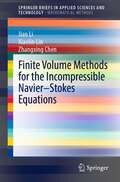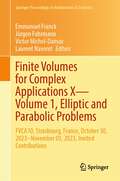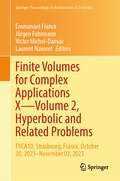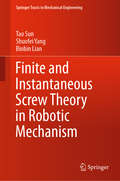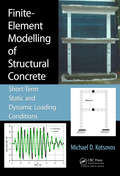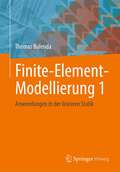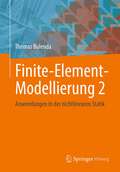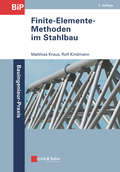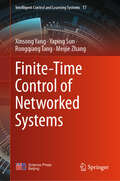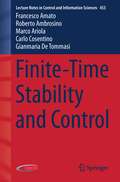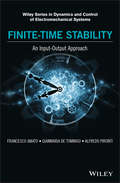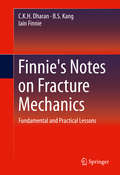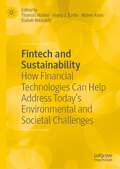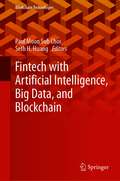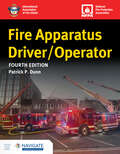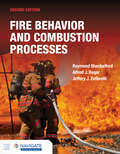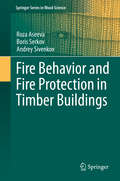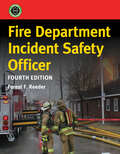- Table View
- List View
Finite Strip Analysis of Bridges
by M.S. Cheung S.E. Chidiac W. LiIn-depth, comprehensive and up-to-date information on the powerful finite strip method of analysis of bridges. It is in three parts. The first introduces the method and gives the necessary background. The second explains the evolution of the method and the third part provides detailed information on the application of the method to highway bridges.
Finite Time Thermodynamics of Power and Refrigeration Cycles
by Pramod Kumar Shubhash C. Kaushik Sudhir K. TyagiThis book addresses the concept and applications of Finite Time Thermodynamics to various thermal energy conversion systems including heat engines, heat pumps, and refrigeration and air-conditioning systems. The book is the first of its kind, presenting detailed analytical formulations for the design and optimisation of various power producing and cooling cycles including but not limited to: * Vapour power cycles* Gas power cycles* Vapour compression cycles* Vapour absorption cycles* Rankine cycle coupled refrigeration systems Further, the book addresses the thermoeconomic analysis for the optimisation of thermal cycles, an important field of study in the present age and which is characterised by multi-objective optimization regarding energy, ecology, the environment and economics. Lastly, the book provides the readers with key techniques associated with Finite Time Thermodynamics, allowing them to understand the relevance of irreversibilities associated with real processes and the scientific reasons for deviations from ideal performance. The book is aimed at a broad readership, and offers a valuable reference book for graduate students, scholars and professionals working in the areas of thermal science and engineering.
Finite Time and Cooperative Control of Flight Vehicles (Advances in Industrial Control)
by Yuanqing Xia Jinhui Zhang Kunfeng Lu Ning ZhouThis book focuses on the finite-time control of attitude stabilization, attitude tracking for individual spacecraft, and finite-time control of attitude synchronization. It discusses formation reconfiguration for multiple spacecraft in complex networks, and provides a new fast nonsingular terminal sliding mode surface (FNTSMS). Further, it presents newly designed controllers and several control laws to enhance the performance of spacecraft systems and meet related demands, such as strong disturbance rejection and high-precision control. As such, the book establishes a fundamental framework for these topics, while also highlighting the importance of integrated analysis. It is a useful resource for all researchers and students who are interested in this field, as well as engineers whose work involves designing flight vehicles.
Finite Volume Methods for the Incompressible Navier–Stokes Equations (SpringerBriefs in Applied Sciences and Technology)
by Jian Li Zhangxing Chen Xiaolin LinThe book aims to provide a comprehensive understanding of the most recent developments in finite volume methods. Its focus is on the development and analysis of these methods for the two- and three-dimensional Navier-Stokes equations, supported by extensive numerical results. It covers the most used lower-order finite element pairs, with well-posedness and optimal analysis for these finite volume methods.The authors have attempted to make this book self-contained by offering complete proofs and theoretical results. While most of the material presented has been taught by the authors in a number of institutions over the past several years, they also include several updated theoretical results for the finite volume methods for the incompressible Navier-Stokes equations. This book is primarily developed to address research needs for students and academic and industrial researchers. It is particularly valuable as a research reference in the fields of engineering, mathematics, physics, and computer sciences.
Finite Volumes for Complex Applications X—Volume 1, Elliptic and Parabolic Problems: FVCA10, Strasbourg, France, October 30, 2023–November 03, 2023, Invited Contributions (Springer Proceedings in Mathematics & Statistics #432)
by Jürgen Fuhrmann Emmanuel Franck Victor Michel-Dansac Laurent NavoretThis volume comprises the first part of the proceedings of the 10th International Conference on Finite Volumes for Complex Applications, FVCA, held in Strasbourg, France, during October 30 to November 3, 2023.The Finite Volume method, and several of its variants, is a spatial discretization technique for partial differential equations based on the fundamental physical principle of conservation. Recent decades have brought significant success in the theoretical understanding of the method. Many finite volume methods are also built to preserve some properties of the continuous equations, including maximum principles, dissipativity, monotone decay of the free energy, asymptotic stability, or stationary solutions. Due to these properties, finite volume methods belong to the wider class of compatible discretization methods, which preserve qualitative properties of continuous problems at the discrete level. This structural approach to the discretization of partial differential equations becomes particularly important for multiphysics and multiscale applications. In recent years, the efficient implementation of these methods in numerical software packages, more specifically to be used in supercomputers, has drawn some attention. This volume contains all invited papers, as well as the contributed papers focusing on finite volume schemes for elliptic and parabolic problems. They include structure-preserving schemes, convergence proofs, and error estimates for problems governed by elliptic and parabolic partial differential equations. The second volume is focused on finite volume methods for hyperbolic and related problems, such as methods compatible with the low Mach number limit or able to exactly preserve steady solutions, the development and analysis of high order methods, or the discretization of kinetic equations.
Finite Volumes for Complex Applications X—Volume 2, Hyperbolic and Related Problems: FVCA10, Strasbourg, France, October 30, 2023–November 03, 2023 (Springer Proceedings in Mathematics & Statistics #433)
by Jürgen Fuhrmann Emmanuel Franck Victor Michel-Dansac Laurent NavoretThis volume comprises the second part of the proceedings of the 10th International Conference on Finite Volumes for Complex Applications, FVCA, held in Strasbourg, France, during October 30 to November 3, 2023.The Finite Volume method, and several of its variants, is a spatial discretization technique for partial differential equations based on the fundamental physical principle of conservation. Recent decades have brought significant success in the theoretical understanding of the method. Many finite volume methods are also built to preserve some properties of the continuous equations, including maximum principles, dissipativity, monotone decay of the free energy, asymptotic stability, or stationary solutions. Due to these properties, finite volume methods belong to the wider class of compatible discretization methods, which preserve qualitative properties of continuous problems at the discrete level. This structural approach to the discretization of partial differential equations becomes particularly important for multiphysics and multiscale applications. In recent years, the efficient implementation of these methods in numerical software packages, more specifically to be used in supercomputers, has drawn some attention. The first volume contains all invited papers, as well as the contributed papers focusing on finite volume schemes for elliptic and parabolic problems. They include structure-preserving schemes, convergence proofs, and error estimates for problems governed by elliptic and parabolic partial differential equations.This volume is focused on finite volume methods for hyperbolic and related problems, such as methods compatible with the low Mach number limit or able to exactly preserve steady solutions, the development and analysis of high order methods, or the discretization of kinetic equations.
Finite and Boundary Element Methods in Engineering
by O.P. GuptaThe interest in finite element method as a solution technique of the computer age is reflected in the availability of many general and special purpose software based on this technique. This work aims to provide a complete and detailed explanation of the basics of the application areas.
Finite and Instantaneous Screw Theory in Robotic Mechanism (Springer Tracts in Mechanical Engineering)
by Tao Sun Shuofei Yang Binbin LianThis book presents a finite and instantaneous screw theory for the development of robotic mechanisms. It addresses the analytical description and algebraic computation of finite motion, resulting in a generalized type synthesis approach. It then discusses the direct connection between topology and performance models, leading to an integrated performance analysis and design framework. The book then explores parameter uncertainty and multiple performance requirements for reliable, optimal design methods, and describes the error accumulation principle and parameter identification algorithm, to increase robot accuracy. It proposes a unified and generic methodology, and appliesto the invention, analysis, design, and calibration of robotic mechanisms.The book is intended for researchers, graduate students and engineers in the fields of robotic mechanism and robot design and applications.
Finite-Element Modelling of Structural Concrete: Short-Term Static and Dynamic Loading Conditions
by Michael D. KotsovosA Powerful Tool for the Analysis and Design of Complex Structural ElementsFinite-Element Modelling of Structural Concrete: Short-Term Static and Dynamic Loading Conditions presents a finite-element model of structural concrete under short-term loading, covering the whole range of short-term loading conditions, from static (monotonic and cyclic) to
Finite-Element-Modellierung 1: Anwendungen in der linearen Statik
by Thomas BulendaEs gibt eine Vielzahl von „Wie-erstelle-ich-ein Finite-Element-Programm?“-Lehrbüchern, aber nur recht wenige Veröffentlichungen zur Frage „Wie wende ich ein Finite-Element-Programm an?“. Dieses Buch legt den Schwerpunkt auf die zweite Fragestellung. Es basiert auf den Vorlesungen zur Anwendung der Finite-Element-Methode, die der Autor seit 1998 an der OTH Regensburg hält. Deren Inhalte kommen aus seiner Tätigkeit als Prüfingenieur für Baustatik in einem großen Münchener Ingenieurbüro. Behandelt werden sowohl Fragestellungen, mit denen sich jeder Ingenieur konfrontiert sieht, wenn er Berechnungen mit einem Finite-Element-Programm erstellen will, als auch Problempunkte, die im Büro des Autors im Zuge einer Projektbearbeitung auftraten und auf den ersten Blick gar nicht so klar waren. In Teil 1 des zweibändigen Werks werden Themen aus der linearen Statik behandelt.
Finite-Element-Modellierung 2: Anwendungen in der nichtlinearen Statik
by Thomas BulendaEs gibt eine Vielzahl von „Wie-erstelle-ich-ein Finite-Element-Programm?“-Lehrbüchern, aber nur recht wenige Veröffentlichungen zur Frage „Wie wende ich ein Finite-Element-Programm an?“. Dieses Buch legt den Schwerpunkt auf die zweite Fragestellung. Es basiert auf den Vorlesungen zur Anwendung der Finite-Element-Methode, die der Autor seit 1998 an der OTH Regensburg hält. Deren Inhalte kommen aus seiner Tätigkeit als Prüfingenieur für Baustatik in einem großen Münchener Ingenieurbüro. Behandelt werden sowohl Fragestellungen, mit denen sich jeder Ingenieur konfrontiert sieht, wenn er Berechnungen mit einem Finite-Element-Programm erstellen will, als auch Problempunkte, die im Büro des Autors im Zuge einer Projektbearbeitung auftraten und auf den ersten Blick gar nicht so klar waren. Der 2.Teil des zweibändigen Werkes befasst sich mit Themen aus der nichtlinearen Statik.
Finite-Elemente-Methoden im Stahlbau (Bauingenieur-Praxis)
by Rolf Kindmann Matthias KrausThe Finite Element Method FEM is a standard method for structural analysis. For practitioners in construction engineering as well as for students, and introduction and all necessary calculations for the design of steel structures according to the Eurocodes (EC 3) are presented.
Finite-Elemente-Methoden im Stahlbau (Bauingenieur-Praxis)
by Rolf Kindmann Matthias KrausThe Finite Element Method (FEM) has become a standard tool used in everyday work by structural engineers having to analyse virtually any type of structure. After a short introduction into the methodolgy, the book concentrates on the calculation of internal forces, deformations, ideal buckling loads and vibration modes of steel structures. Beyond linear structural analysis, the authors focus on various important stability cases such as flexural buckling, lateral torsional buckling and plate buckling along with determining ideal buckling loads and second-order theory analysis. Also, investigating cross-sections using FEM will become more and more important in the future. For practicing engineers and students in engineering alike all necessary calculations for the design of structures are presented clearly.
Finite-Time Control of Networked Systems (Intelligent Control and Learning Systems #17)
by Xinsong Yang Yaping Sun Rongqiang Tang Meijie ZhangThis book mainly provides recent advances in finite-time and fixed-time control issues for complex networks and neural networks. It is well known that finite-time techniques have more advantages over asymptotical ones. Besides fast convergence rates, finite-time techniques have better robustness and disturbance rejection properties. However, it is challenging to deal with time delay in studying finite-time control. For readers’ easy understanding, the finite-time control issue for systems with and without time delays is separately introduced in this book. Moreover, the issues of finite-time and fixed-time control for differential equations with discontinuous states on the right-hand side are also considered. Many interesting results concerning finite-time and fixed-time synchronization are provided in the form of lemmas, theorems, or corollaries, accompanied by systematic theoretical analysis for the proof of their sufficient conditions, controller design, and new analysis techniques. Each new result is verified by at least one numerical example with detailed data analysis. Therefore, this book is an advantageous tool and is beneficial for interested experts and scholars in the control field.
Finite-Time Stability and Control
by Francesco Amato Roberto Ambrosino Marco Ariola Carlo Cosentino Gianmaria De TommasiFinite-time stability (FTS) is a more practical concept than classical Lyapunov stability, useful for checking whether the state trajectories of a system remain within pre-specified bounds over a finite time interval. In a linear systems framework, FTS problems can be cast as convex optimization problems and solved by the use of effective off-the-shelf computational tools such as LMI solvers. Finite-time Stability and Control exploits this benefit to present the practical applications of FTS and finite-time control-theoretical results to various engineering fields. The text is divided into two parts: · linear systems; and · hybrid systems. The building of practical motivating examples helps the reader to understand the methods presented. Finite-time Stability and Control is addressed to academic researchers and to engineers working in the field of robust process control. Instructors teaching graduate courses in advanced control will also find parts of this book useful for their courses.
Finite-Time Stability: An Input-output Approach (Wiley Series in Dynamics and Control of Electromechanical Systems #453)
by Francesco Amato Gianmaria De Tommasi Alfredo PirontiSystematically presents the input-output finite-time stability (IO-FTS) analysis of dynamical systems, covering issues of analysis, design and robustness The interest in finite-time control has continuously grown in the last fifteen years. This book systematically presents the input-output finite-time stability (IO-FTS) analysis of dynamical systems, with specific reference to linear time-varying systems and hybrid systems. It discusses analysis, design and robustness issues, and includes applications to real world engineering problems. While classical FTS has an important theoretical significance, IO-FTS is a more practical concept, which is more suitable for real engineering applications, the goal of the research on this topic in the coming years. Key features: Includes applications to real world engineering problems. Input-output finite-time stability (IO-FTS) is a practical concept, useful to study the behavior of a dynamical system within a finite interval of time. Computationally tractable conditions are provided that render the technique applicable to time-invariant as well as time varying and impulsive (i.e. switching) systems. The LMIs formulation allows mixing the IO-FTS approach with existing control techniques (e. g. H∞ control, optimal control, pole placement, etc.). This book is essential reading for university researchers as well as post-graduate engineers practicing in the field of robust process control in research centers and industries. Topics dealt with in the book could also be taught at the level of advanced control courses for graduate students in the department of electrical and computer engineering, mechanical engineering, aeronautics and astronautics, and applied mathematics.
Finnie's Notes on Fracture Mechanics
by C. K. H. Dharan B. S. Kang Iain FinnieThis textbook consists primarily of notes by Iain Finnie who taught a popular course on fracture mechanics at the University of California at Berkeley. It presents a comprehensive and detailed exposition of fracture, the fundamentals of fracture mechanics and procedures for the safe design of engineering components made from metal alloys, brittle materials like glasses and ceramics, and composites. Interesting and practical problems are listed at the end of most chapters to give the student practice in applying the theory. A solutions manual is provided to the instructor. The text presents a unified perspective of fracture with a strong fundamental foundation and practical applications. In addition to its role as a text, this reference would be invaluable for the practicing engineer who is involved in the design and evaluation of components that are fracture critical. This book also: Presents details of derivations of the basic equations of fracture mechanics and the historical context of the development of fracture theory and methodology Treats linear and nonlinear fracture mechanics methodologies beginning with a review of the basic equations of solid mechanics followed by solutions useful in fracture prediction Illustrates the basis of linear elastic fracture mechanics (LEFM), practical applications of LEFM in the design of fracture-tolerant structural components Offers interesting, practical, classroom proven problems at the end of most chapters Includes instructor's solutions manual
Fintech and Sustainability: How Financial Technologies Can Help Address Today’s Environmental and Societal Challenges
by Thomas Walker Maher Kooli Elaheh Nikbakht Harry J. TurtleFintech can improve sustainability, influence policies, and require new regulations. Climate change, water pollution, and non-renewable resources management can all be addressed with fintech innovations. Despite the advantages offered by fintech, opponents warn of potential negative consequences. The application of fintech in sustainability is a double-edged sword requiring further investigation. This book provides an overview of fintech applications and considers their impact on the future of sustainable finance. It explores how financial technologies can enhance the sustainability of investment and corporate decisions and contribute to the fulfillment of the Sustainable Development Goals (SDGs). By considering practitioner and academic views, it examines whether and how fintech can improve sustainable practices, potential threats with possible solutions, and policies and regulations designed to improve sustainability benefits.
Fintech with Artificial Intelligence, Big Data, and Blockchain (Blockchain Technologies)
by Paul Moon Sub Choi Seth H. HuangThis book introduces readers to recent advancements in financial technologies. The contents cover some of the state-of-the-art fields in financial technology, practice, and research associated with artificial intelligence, big data, and blockchain—all of which are transforming the nature of how products and services are designed and delivered, making less adaptable institutions fast become obsolete. The book provides the fundamental framework, research insights, and empirical evidence in the efficacy of these new technologies, employing practical and academic approaches to help professionals and academics reach innovative solutions and grow competitive strengths.
Fire
by Sebastian JungerSebastian Junger details his first-hand experiences as he describes fire fighting. As a seasoned journalist he travels the world and brings the reader face to face with many crises.
Fire Apparatus Driver/Operator with Navigate Advantage Access
by Patrick P. DunnBrought to you in partnership with the NFPA and the IAFC, Fire Apparatus Driver/Operator, Fourth Edition is a complete print and digital training solution that addresses preventive maintenance, pump operations, safe driving techniques, tiller and aerial apparatus operations, and mobile water supply considerations.
Fire Behavior and Combustion Processes with Advantage Access
by Raymond ShackelfordFire Behavior and Combustion Processes, Second Edition provides a straightforward, comprehensive resource for students in fire science degree programs, an up-to-date refresher for active firefighters, and an engaging experience for all learners.
Fire Behavior and Fire Protection in Timber Buildings
by Roza Aseeva Boris Serkov Andrey SivenkovThis volume describes fire behavior and fire protection of timbers in outdoors and indoors application mainly in construction industry. The Authors' novel approach considers the relationship between various species and age of timbers and its fire behavior at different thermal and fire loads. Quantitative data of ignition speed and flame propagation as well as generation of heat, smoke and toxic products are discussed. Analysis of fire resistance of various types of building materials based on timber of different species as well as the novel data on the effect of natural and accelerated aging of timbers on its fire behavior are discussed. The main practical methods of fire protection of new and ancient timber buildings and structures to increase its fire resistance are considered. The book should be useful for a wide range of readers: chemists, physicists, material scientists, architects, engineers, constructors and restorers.
Fire Department Incident Safety Officer
by Forest F ReederFire Department Incident Safety Officer, Fourth Edition with Navigate Advantage Access is a print and digital solution that prepares aspiring and current incident safety officers (ISOs) to meet and exceed the specific job requirements outlined in NFPA 1550, which includes Chapter 5, Incident Safety Officer (NFPA 1521).
Fire Design of Steel Structures: EC1: Actions on structures; Part 1-2: Actions on structure exposed to fire; EC3: Design of steel structures; Part 1-2: Structural fire design
by Paulo Vila Real Jean-Marc FranssenThis book explains and illustrates the rules that are given in the Eurocodes for designing steel structures subjected to fire. After the first introductory chapter, Chapter 2 explains how to calculate the mechanical actions (loads) in the fire situation based on the information given in EN 1990 and EN 1991. Chapter 3 is dedicated to the models which represent the thermal actions created by the fire. Chapter 4 describes the procedures to be used to calculate the temperature of the steelwork from the temperature of the compartment and Chapter 5 shows how the information given in EN 1993-1-2 is used to determine the load bearing capacity of the steel structure. Chapter 6 presents the essential features that characterize the advanced calculation models, for thermal and mechanical response. The methods used to evaluate the fire resistance of bolted and welded connections are described in Chapter 7. Chapter 8 describes a computer program called `Elefir-EN? which is based on the simple calculation model given in the Eurocode and allows designers to quickly and accurately calculate the performance of steel components in the fire situation. Chapter 9 looks at the issues that a designer may be faced with when assessing the fire resistance of a complete building. This is done via a case study and addresses most of the concepts presented in the previous chapters. For this second edition the content has been revised and extended. The book contains some new sections, e.g. a comparison between the simple and the advanced calculation, as well as additional examples.
